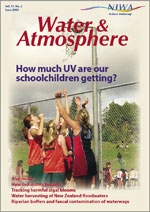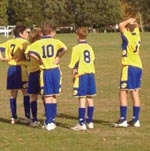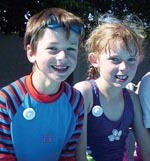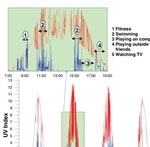PDF of this article (369 KB)

Caradee Wright, Greg Bodeker, and Tony Reeder have created a unique database that links sun exposure to school children’s day-to-day activities, knowledge, and attitudes about keeping sun-safe.

Enjoying lunch in the midday sun? A game of tennis after school? How much solar ultraviolet (UV) radiation does a child receive while participating in these and other, often routine, activities? In New Zealand, where skin cancer rates are the highest of all cancers, knowing the level of risk is crucial for designing safe social and physical environments which can prevent excess UV exposure. In terms of skin cancer risk, getting sunburnt when you are young may be more damaging than getting sunburnt as an adult.
In 2004, we began a three-year project to link measurements of personal UV radiation exposure of primary and intermediate schoolchildren with their activities, knowledge, attitudes, and behaviours. This was a first for New Zealand. This project, funded by the Cancer Society of New Zealand, NIWA, and the University of Otago, brings together a research team of physicists from NIWA and social scientists from the University of Otago’s Social and Behavioural Research in Cancer Group.

Over the summer of 2004–05, we measured the UV exposure of 491 schoolchildren at 27 schools over 14 one-week periods. The children wore electronic monitors specifically developed for us by Martin Allen at the University of Canterbury. The monitors logged UV exposure at 8-second intervals through-out the day. These measurements have been combined with data from questionnaires to create a unique database that can be used to answer many questions related to UV exposure of schoolchildren.
Constructing the database
The 27 schools in our experiment were randomly selected from five geographical regions:
- Christchurch (Christchurch, Waimakariri, and Selwyn districts),
- Otago/Southland (Dunedin, Central Otago, Invercargill),
- Auckland (Auckland, Manakau),
- Waikato (Hamilton, Waikato district), and
- Wellington (Hutt, Porirua, Wellington).
Two groups of school students, one of about age 8 years old and the other of about age 12, were invited to participate. Each student wore a personal UV monitor and filled in an activity diary for seven consecutive days. The students also recorded whether they were using any sun protection during each activity. To help us understand their actions, we used a questionnaire to assess their knowledge and attitudes about sun safety. Students’ skin phototypes were also recorded, since this may be an important factor affecting the likelihood of sunburn. We assessed the physical and social environment of each school by looking at the buildings and shade structures, as well as talking with staff and reading school policy documents. By talking with the health promotion staff of agencies such as the Cancer Society, we found out to what extent the local community promotes sun protection, at schools in particular.

Using a UV monitor identical to those worn by the students, we recorded ambient UV levels at each school to determine the local UV Index (UVI). Towards the end of each week at each school, we provided an interactive UV/sun-protection workshop, with links to UV and ozone information, the UVI, and UV effects on human health.
An example of the data recorded by a student’s UV monitor is shown in the graph, together with the local UVI and extracts from their activity diary for selected activities. From this illustration it can been seen that most of the time the UV exposure experienced by the child is significantly less than the local UVI (which is based on UV received on a horizontal surface). However, there are times when the UV exposure is higher than the UVI, for example the early morning of 17 February. This is because the sun is lower in the sky at this time of day and the radiation received on a horizontal surface (used to calculate the UVI) is likely to be less than that incident on a student standing upright.
Putting it all together
The database resulting from our fieldwork will quantify how much UV a child receives for the activity that they were doing at a particular time and in a particular place. We will then know which activities, in which geographic areas, are associated with high UV exposure. We have developed unique software to link together the students’ activities as recorded in their diaries with their UV data as measured using the monitors. For each activity, three UV doses are calculated: the students’ dose using their personal UV monitor, the local UVI measured on site at each school, and a modelled clear-sky UV exposure. One file is created for each student and, using a unique student identifier, linked to their questionnaire and skin type data. Armed with this information, we are now able to answer questions such as: ‘For students who play soccer after school and who are aware of the UVI, what was their UV dose while they were playing soccer, and were they at risk of getting sunburnt?’ Using this information, we will be able to draft guidelines for the development and implementation of effectively targeted sun-protection strategies.
The database will be an invaluable source of information for developing health promotion programmes and will provide a baseline against which those programmes can be evaluated and any changes identified. The database will also be valuable for use in future research, in particular, studies of skin cancer epidemiology.
The project is the first of its kind in the world. As such, it will make a valuable contribution to international skin-cancer literature, which currently lacks any studies of the links between actual time-based UV exposure of school children, concurrent activities, and social and environmental factors.
Useful terms
Epidemiology: The study of the distribution and determinants of health-related conditions and events in a population.
Erythema/sunburn: One of the acute health effects of excess UV exposure is the familiar reddening of the skin, commonly known as sunburn, and medically termed erythema. The degree of erythema will depend on your skin type and your ability to adapt to UV exposure.
Skin cancer: There are two broad types of skin cancer, non-melanoma (NM) and malignant melanoma (MM). NM is most often prevalent on frequently exposed body parts, such as the face and forearms, suggesting that long-term, frequent UV exposure may be a predominant cause. It is not often fatal (86 deaths in NZ in 2000), although surgical removal may be painful and disfiguring. MM more frequently results in death (253 deaths in 2000) and its risk seems to correlate with genetic characteristics and individual UV exposure patterns. The estimated health system treatment cost for skin cancers in NZ is $33 million per annum.
Ultraviolet radiation: UV radiation comes from the sun as well as artificial sources, such as certain machines used in industry and commerce. The UV region, a part of the electromagnetic spectrum, consists of the wavelengths from 100 to 400 nm and is divided into three bands: UVA (315–400 nm), UVB (280–315 nm) and UVC (100–280 nm).
UV Index: The UVI is a relatively simple measure of UV taken at the earth’s surface. The UVI ranges from zero upwards and the higher the number, the greater the risk of potential damage to the human body. The UVI, therefore, indicates the possibility that adverse health effects may occur and provides opportunities for recommending appropriate sun protection precautions.
Useful links
Sunsmart in NZ: www.sunsmart.co.nz/
US EPA SunWise programme: www.epa.gov/sunwise
World Health Org – ultraviolet radiation: www.who.int/topics/ultraviolet_radiation
World Health Org – UV Index: www.who.int/mediacentre/factsheets/who271
UV in New Zealand: www.niwa.co.nz/services/uvozone
Ms Caradee Wright is a PhD student in public health at the University of Otago. Dr Greg Bodeker, who leads NIWA’s ‘Drivers and Mitigation of Global Change’ programme, is based at NIWA in Lauder. Dr Tony Reeder is with the Social and Behavioural Research in Cancer Group (S&BRCG) at the University of Otago.
The authors thank the Cancer Society of New Zealand Inc., the National Research Foundation of South Africa, NIWA, and the University of Otago for funding. They also acknowledge the contributions of their colleagues in the project: Dr Richard McKenzie and Ms Hisako Shiona (NIWA), Mr Martin Allen (Canterbury), and Ms Vanessa Hammond (S&BRCG).
Author contact: [email protected]
Teachers’ resource for NCEA AS: Biology 90714 (3.2); Science 90186 (1.1), 90313 (2.2) See other curriculum connections at www.niwa.co.nz/pubs/wa/resources
